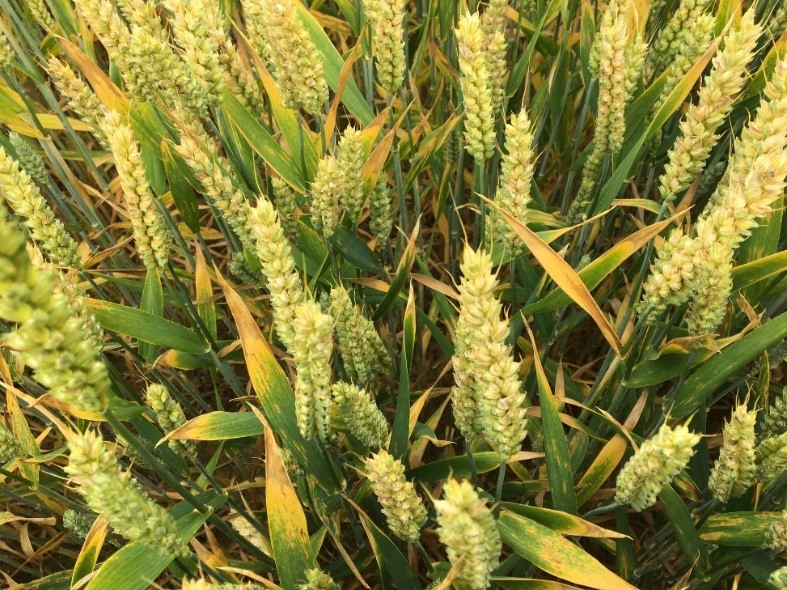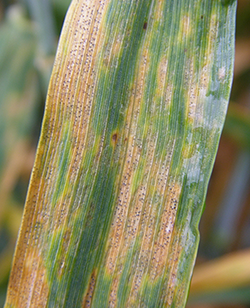Resistance examples in cereals
Septoria resistance
In the mid 1980s, M. graminicola developed resistance to benzimidazole fungicides (MBCs). Isolates resistant to QoI fungicides were first detected in 2002 and are now widespread throughout the country at high levels. Sensitivity to DMIs has declined since the mid 90s with notable increases in the frequency of resistant isolates occurring during 2003 and 2004. Since then, the sensitivity of Septoria to the DMIs has continued to decline and field performance, particularly at reduced doses, has deteriorated further. Several azoles, primarily epoxiconazole and prothioconazole, continue to provide relative good control at full label doses. Regarding sensitivity to SDHI only a few isolates has so far been found which show reduced sensitivity to this group of fungicides.
Triazoles and Septoria control
Current evidence shows a significant shift towards reduced sensitivity to DMIs. Field performance from the most effective products has still been good in recent years as long as appropriate timings and doses were used. The curativity of the products seems to be most influenced by the shifting.
There is now considerable variation in performance of active ingredients in this group and to ensure good performance it is important to select appropriate DMI products.
All azoles have the same mode of action inhibiting sterol 14α-demethylase (CYP51). Consequently it has been assumed that if resistance occurred in a pathogen then all azoles would be equally affected. This is now known not to be true. A large number of mutations in the azole target site protein have now been identified, some of which affect the sensitivity of M. graminicola to particular azole fungicides, while others have no measurable impact on sensitivity.
- Use in mixture with fungicides with good efficacy e.g. SDHI or chlorothalonil. Use at an effective dose to ensure a high level of disease control.
- Do not use DMIs alone. Alternate or mix fungicides with different modes of action in repeat spray programmes if possible.
- Because CYP51 mutations affect DMI fungicides in different ways it is theoretically possible that mixtures of azoles could help slow down further shifts in sensitivity. However, the number and complexity of mutations is very dynamic, making it difficult to predict the performance of multiple azole products.
SDHIs and Septoria control
In 2015 the first signs for field resistance to SDHI fungicides where detected in Ireland and UK
In November 2015, Rothamsted Research reported low frequencies of septoria isolates with reduced SDHI sensitivity in UK field populations, while earlier this month Teagasc in the Republic of Ireland confirmed the detection of field isolates of septoria with reduced sensitivity to SDHIs.
Ireland have seen lower efficacy from SDHI product in field trials in both 2017 and 2018 and there is increasing evidence of mutant strains with reduced sensitivity (e.g. C-T79N. C-H152R). Septoria isolates with reduced sensitivity to SDHIs are now found in UK, Ireland, Netherland, Northern Germany and part of France.
A relative high level of cross resistance have been identified for SDHI fungicides, but the correlation varies between specific SDHI’s and mutations . Positive cross‐resistance relationships between boscalid, penthiopyrad and isopyrazam, and a lack of cross‐resistance between fluopyram and other SDHIs have been reported for some SDHI‐resistant lab mutants and field strains of several fungi (Yamashita & Fraaije 2918).
More research is needed to determine how these findings impact on disease control in the field. Although field performance from SDHIs is still anticipated to be good in 2016, strong stewardship is needed to prevent a rapid increase in the frequency of such isolates in the septoria population.
Strong stewardship is needed to prevent a rapid increase in the frequency of isolates with reduced sensitivity to SDHIs in the septoria population. The new information on SDHI sensitivity, once again, shows why it is critical to adopt best resistance management practices. This include
- Follow the statutory requirement to limit the number of applications to two SDHI fungicide-containing sprays
- Always use SDHI fungicides in mixture with a fungicide from an alternative mode of action group, which has comparable efficacy against the target pathogen(s)
- Tank mixing SDHIs is not an anti-resistance strategy. In any tank mix the SDHI should be applied in a balanced mixture with at least one fungicide with comparable efficacy against the target pathogens from an alternative mode of action group
Source: FRAG SDHI statement 2016
Super SDHI-resistant septoria isolates found in UK crops /12 May
Untreated plot in Ireland
SDHI’s do not provide good controlled anylonger in Irish fields with –> 75% C-T79N mutations. This mutations cause reduction in field performances.
Acceptable control could still be obtained when combining SDHI’s with azoles and chlorothalonil in a 3 spray strategy.
 |  |
Two treatments (Providing insufficient control). 2 x 0.8 l Elatus Era (Solatanol + prothioconazole. (T1 + T2) | Three treatments.1.2 l Ascra xpro + 1.0 Bravo, (T1); 1.6 Librax + 1.0 Bravo (T2), 1.0 Prosaro (T3). Acceptable control could still be obtained when combining SDHI’s with azoles and chlorothalonil in a 3 spray strategy |
